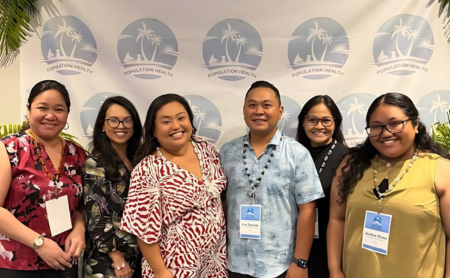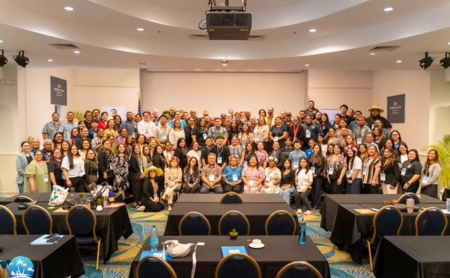Population Health Summit Strengthens Pacific Partnership
September 16, 2025 | Anya Groner
For Halina Palacios, chief operations officer of public health for the Commonwealth Healthcare Corporation, it was important to break the mold and host a public health summit in the Pacific instead of the Continental United States. She and her team held the corporation's inaugural Population Health Summit in the Commonwealth of the Northern Mariana Islands (CNMI).
With firsthand knowledge of the notable work happening across the Pacific, Palacios hoped to create a venue where public health workers from U.S. territories and freely associated states could share their successes and learn from each other.
Improving Pacific Collaboration and Confidence
Regional collaboration is not new to the Pacific. During the COVID-19 pandemic, the U.S.-Affiliated Pacific Islands (USAPI) worked together to limit transmission until most of their populations could get vaccinated. Palacios knew that a summit hosted in CNMI would build on this existing regional collaboration.
Public health summits are typically held in the continental United States and come with high travel costs, meaning that only one or two representatives from each jurisdiction can attend. As a result, the majority of Pacific public health teams don’t directly benefit from information sharing and networking at such conferences. Holding a summit within the region instead would lower those travel costs and boost attendance.
In addition, Palacios felt a local summit would boost confidence in Pacific public health officials: The officials who were able to attend public health conferences in the continental United States sometimes told her they felt imposter syndrome, caused in part by the feeling of being in a tiny minority at a national event and from attending presentations that didn’t necessarily address local realities.
Turning Vision into Reality
Putting together a conference is a massive undertaking, but Palacios knew her team could do it.
They chose “Navigating Pathways Through the Pacific: Building Healthier and Stronger Island Communities” as the theme of the inaugural summit. Broad and ambitious, it encompassed Palacios’s expansive vision. She wanted the event to encourage public health programs across the Pacific to operate with a population health mindset, addressing not only individual medical concerns but also the social, economic, and environmental factors that influence community health outcomes.
Spanning three days, the summit schedule included various plenaries, poster presentations, and panel discussions on behavioral health, public health, and clinical practice — centering topics relevant to the region. The team invited faith group leaders and members of recovery communities to speak alongside specialists from throughout the region.
“The expertise in the Pacific consists of individuals with degrees, lived experiences, and traditional teachings, and it is our job to acknowledge and share how proud we are of our people.”
– Palacios

An Impactful Inaugural Event
The inaugural summit occurred this past June in CNMI’s capital city, Saipan, and turnout was high. In addition to strong representation from CNMI, more than 50 people came from off-island to share resources, compare programs, and form new collaborations. Popular topics included data capacity, expanding approaches to behavioral health, technical assistance opportunities, and clinical resources. The impact was immediate.
Two speakers, Oncologist Peter Brett and Dentist Angelina Sabino, with clinics in their respective fields at the Commonwealth Healthcare Corporation, educated attendees on the realities they face treating the community. This session led to post-discussions, opening opportunities to collaborate with other USAPI on addressing oral cancer in the Pacific, which is especially important due to recent reductions in national surveillance, technical assistance, and funding for tobacco prevention programs. Island jurisdictions have high rates of oral cancer as a result of betel nut use with tobacco and high smoking rates — and with patients often seeking treatment in Guam, Hawaii, or elsewhere in Asia, the team knew it was a topic that the summit needed to cover.
Another topic of particular interest was research and accountability. A panel discussion, which included Palacios, sought to improve data collection and research across the region. Participants noted the need for a centralized Institutional Review Board in CNMI to review and monitor research on human subjects. Without it, health officials can’t easily standardize research methods and practices. Panelists also expressed a need to set higher expectations for researchers who conduct studies using data from the Pacific Island jurisdictions; many fail to meaningfully share the results of their work with participants or public health teams, often doing little more than emailing a link to an article or a Zoom presentation.
“If you're smart enough to study us, please be smart enough to explain how we can implement your recommendations.”
– Palacios
The Population Health Summit purposefully centered on Pacific Island culture — each day, it opened and ended with a prayer. Instead of being part of a tiny minority at a large conference on the mainland, participants saw themselves represented in the daily schedule, with presenters from within their community, speaking on topics that addressed their concerns.

Looking Ahead
Though only a few months have passed since the summit, new projects and collaborations are underway. Some attendees are contacting presenters to schedule training sessions for staff who couldn’t attend. Others are sharing resources on topics such as men’s behavioral health and accountability. Most encouraging for Palacios are the conversations about the next population health summit: who will host it, when it will be, and what the presentation topics might be.
Over the next five years, a new cohort of public health workers will start their careers in CNMI and across the Pacific Island jurisdictions. By then, Palacios predicts that the Population Health Summit will be well established and that standards for the profession will have shifted.
This product was supported by the Centers for Disease Control and Prevention of the U.S. Department of Health and Human Services (HHS) as part of a financial assistance award totaling $1,000,000 with 100 percent funded by CDC/HHS. The contents are those of the author(s) and do not necessarily represent the official views of, nor an endorsement, by CDC/HHS, or the U.S. Government.